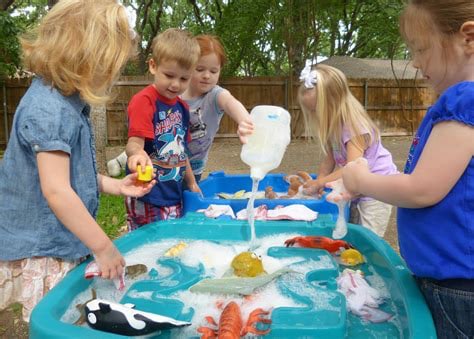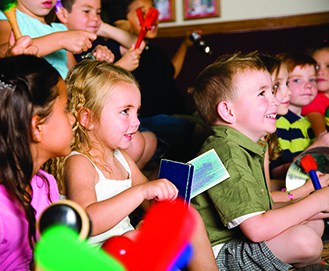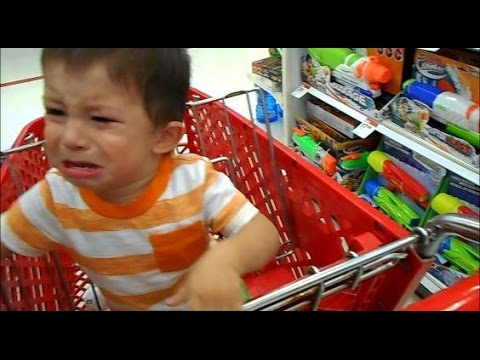Water – Refreshing And Educational for Your Child
Separation Anxiety

Wasn’t it nice when your infant preferred you to anyone else on the planet? Now that your child is bigger, though, and he falls apart whenever you head to the bathroom without him, his attachment seems downright obsessive. He’s experiencing separation anxiety, a developmental phase that nearly all children go through during their early years.
Why separation anxiety happens
At around 6 months, your baby begins to realize that you and he are separate, which means that you could leave him. He’s also capable of “representational thinking” now, which means that he can picture objects (like you) in his mind after they’re no longer visible. In other words, out of sight no longer means out of mind. (This is one reason why he suddenly gets such a kick out of “peekaboo.”) As your child grows into toddlerhood, he’s developing a strong drive for independence, but he still needs your undying support. All this can lead to a fear that you’ve abandoned him whenever you’re not there.
What to do
Wave bye-bye when you leave. It’s a simple tactic but one that many parents ignore. Instead, fearing the wrath of their toddler, they try to sneak out while he’s otherwise engaged. This approach may save you the pain of watching your child cry, but it can actually make his separation anxiety more severe.
Help your child look ahead.
Although your child’s ability to communicate is still hindered by his limited vocabulary, he understands much more than he can say. So, prepare him for your departure. Make sure your child knows where you are going and when you’ll be back. You may also want to give him details, such as who will be watching him and what sort of activities he can look forward to doing.
Allow your toddler and his caregiver to get engrossed in an activity before you leave. When the time comes for you to go, give your child a quick kiss goodbye and make a beeline for the door. He may still cry, but the activity can serve as a distraction soon after your departure.
Let him learn to cope. No parent wants her child to feel any unnecessary sadness, but coping with separation is one of the many stresses your child will have to learn to manage in life.
Source: Dawn Margolis, Baby Center
How to Handle the Curiosity of a Toddler
“WHYWHYWHY:” why does this word and the never-ending repetition of it make up a toddler’s entire vocabulary? How do we deal with the curiosity that comes from such a simple question? Toddlers are known to be curious little things that never seem to sit still. We can always count on them to be tottering half a room away looking for the next item on the list for destruction. When toddlers continuously ask us the ‘why’ question, they are trying to make sense of the world around them. While it may seem easier to just give them the whole spiel on why it’s raining, that’s not how toddlers’ brains work. They need to make sense of the answers they get one step at a time. They learn new things everyday through observation and little facts. Berate them with a bucket of facts on how the world works and you’ll have one very confused tot.
Stumped by some of the questions your little one asks you? You are definitely not alone. Toddlers ask so many questions that there are a number of books out there just to help parents answer them. Catherine Ripley’s Why?: The Best Ever Question, and Answer Book About Nature, Science, and the World Around You are two great books that you can take advantage of. Brain Quest also has a lot of games with questions and answers for toddlers and parents alike.
Improving Attention Spans
Child development experts say that, on average, a four or five year old child should be able to stay focused on a particular activity two to five minutes times the year of their age. With this in mind, your child should be able to focus between four and twenty minutes depending on the task. If you find that your child is not able to focus on a given task at hand for very long, there may be some things you can try to increase attentiveness.
For one, it takes attention to give attention. If your own attention is scattered, then don’t expect your child to have laser focus. Close proximity with your child and clear instructions on the task are essential in making progress.
You can also decrease distractions by facing said diversion before it becomes a problem. If you sense hunger or fatigue, offer up a healthy snack. Nap time? Put that child to bed! You know that nothing will get done with multiple children in the room? Separate rooms for each child may be an option.
Ensure that your child is getting enough breaks. If your little one is getting restless, ask yourself when their last rest time was. Centers for Disease Control and Prevention research review from 2010 showed that elementary aged children who took breaks from work over the course of the school day ended up concentrating better on schoolwork.
Last but not least, limit that electronic time. It’s almost becoming annoying how often the phrase, ‘limit electronics,’ is being used. Though it’s a good motto to have. The American Academy of pediatrics recommends a maximum of two hours of screen time a day.
Continue reading “Improving Attention Spans”
Why Music Lessons Might be Helpful for Child Development
We’ve discussed ways to get your little one involved in extracurricular activities and one of the ideas mentioned was playing an instrument. Playing an instrument can do a lot of good for your little one. There are a multitude of benefits such as the development of physical and social skills, patience and discipline and a boost in self-esteem.
Physical skills are improved, as certain instruments require movement to be played. Drums require coordinated arm and leg action while violins entail simultaneous movement from both hands. Instruments help develop ambidexterity as well an improvement in coordination.
Social skills can also be improved through music lessons. If it is a group music lesson, then teamwork and communication are required to play as said member of the group. Children need to understand their particular role in the larger ensemble to create music.
Patience and discipline also play a large role in learning to play an instrument. Discipline is used in habitual practice of the instrument. Patience is required, as one will not master an instrument immediately. Many instruments have a steep learning curve. For example, before an instrument can even be played, one has to know how to read music notes.
As a child learns to play an instrument, self-esteem is built. Constructive criticism and the slow progress of getting better will teach your child that hard work pays off.
At Minnieland Academy, children gather to create music, sing songs, clap and dance each day. Age appropriate musical instruments are available in our classrooms.
Continue reading “Why Music Lessons Might be Helpful for Child Development”
Eco-Friendly Families: How to Reduce Plastic in Your Home & Day
Most of us can’t imagine a world without plastic. It’s in everything – from bottles to toys to even your food packaging! While it’s hard to completely cut it out, reducing how much you use is not only good for your health, but also the environment, too.
It’s almost impossible to know what exactly is in a plastic product as there are also additives that strengthen, color and add scent to the product. Researchers are still uncertain as to how plastic affects us in our day-to-day lives. While we are still unsure about the consequences that plastic products have in our lives, there are ways to limit exposure and to be on the safe side.
- Cut back on processed and packaged foods
- Pack lunch items in unbleached wax paper and reusable containers made of ceramic, glass of stainless steel instead
- Bring reusable shopping bags to the store instead of single-use plastic bags
- Store food in glass jars and containers instead of plastic tubs
- Stop using plastic water bottles and buy a reusable BPA-free water bottle
Founded in 1972 by Chuck and Jackie Leopold, Minnieland Academy has provided Virginia families with the best early childhood education and care for over 40 years. We have over 60 schools that serve infants through school age children, helping them develop in a loving environment. We believe that learning is fun, and our Kid Steps curriculum provides age appropriate education at every level of their growth.
Come tour one of our schools and become part of the Minnieland Academy Family! https://www.minnieland.com
Public Tantrums? Here’s How to Handle Them
Another tantrum in the store?
Ah…the beloved moment when your child begins to act as a human windshield wiper against the grocery store floor. It’s a humbling experience for all to go through a public temper tantrum. We’ve gathered some tips and thoughts on how to turn the embarrassment level from a 10 to a 5. Let us know what you think.
- Before going anywhere, try to stock your bag with snacks and drinks. Sometimes all it takes for a meltdown is a want for food. Sure, your food may not be the object of desire as you stroll by the chocolate chunk cereal….but it may appease the anger for a little longer.
2. Be an example of how to act: You want to pull your hair out. We get it. Completely. But your toddler doesn’t need to know this. This fact may only make your little one more upset. Stay calm and take deep breaths. Rushing out of the store won’t make your child any more calm. In fact, it may cause more agitation. Once out of the center of attention, keep your wits. Don’t attempt ending the ordeal quickly. Rushing the process is a recipe for disaster. Sit down with your little one and let them know you understand how they’re feeling. Pat them on the back or sit them in your lap. Let the little one know it’s okay to have bad feelings but that it’s time to calm down.
- “What can I do for you?”: Asking a question like this lets your little one know you are on their side. It does not mean you will give them what they want, but opens up a dialogue to explain the situation. Maybe they can’t have that lollipop because it has too much sugar…but they can have an oatmeal bar! No matter what – don’t give in to the reason of the temper tantrum no matter what. It will only make your child realize that all they have to do is throw a fit to get anything they want. Stick to your ground and keep calm. You’ll get through it…we promise!
Minnieland Academy provides early childhood education and care for infants through school-age children.
Founded in 1972 by Chuck and Jackie Leopold, Minnieland Academy has provided Virginia families with the best early childhood education and care for over 40 years. We have over 60 schools that serve infants through school age children, helping them develop in a loving environment. We believe that learning is fun, and our Kid Steps curriculum provides age appropriate education at every level of their growth.
Come tour one of our schools and become part of the Minnieland Academy Family! https://www.minnieland.com
Improving Vocabulary…One Meal at a Time
The Jar
Place a jar on your dinner table filled with new vocabulary words. Have your children pull a word out of the jar. Go around the table and discuss associations you may have with the word. It’s a great time to chat and also an amazing learning opportunity for your children.
Word Art
Before sitting down at the table, supply every family member with a few colored pencils and a slip of paper. Choose a word out of the dictionary (or maybe your word jar that you’ve created) and have everyone doodle what comes to mind when they hear the description of the word. What’s not fun about doodling (with a side of learning?)?
Discovery Time
Task every family member with finding a new word for the day. When it comes time to sit down for dinner, every family member shares their word and says why they like it. At the end of the week, whoever remembers the most words from this activity wins a prize (maybe a cupcake for dessert)!
Minnieland Academy provides early childhood education and care for infants through school-age children. We believe in learning in a loving environment.
Founded in 1972 by Chuck and Jackie Leopold, Minnieland Academy has provided Virginia families with the best early childhood education and care for over 40 years. We have over 60 schools that serve infants through school age children, helping them develop in a loving environment. We believe that learning is fun, and our Kid Steps curriculum provides age appropriate education at every level of their growth.
Come visit one of our schools and become part of the Minnieland Academy Family! https://www.minnieland.com
Your Child Wants a Pet…What Now?
- Try visiting an animal shelter and spending time with the dogs and cats there. This can either be to see how your child interacts with pets or it could be a opportunity to give your child animal time, without actually buying an animal.
- If you are not opposed to having a pet, maybe negotiate on a smaller one to start with (maybe hamster size).
- Reach out to neighbors with animals and let your child spend time with these animals (you will need to be sure your neighbor is aware of this new implementation and also okay with it). If your neighbor is willing, you could even try having your child help out with the care (like feeding and walking etc.) and see how things go from there.
- Have your child first demonstrate that they can handle basic chores. Another idea would be the ‘go-to-plant-plan.’ Give your child a plant and tell them if they can keep the plant healthy for a certain amount of time, then maybe they can handle the responsibility of having an animal.
- Whatever you decide, give your child the complete run through of why or why not the decision to get a pet would be a good or bad idea. The worst thing to do is to simply say ‘no, I don’t want a dog etc..’ Explain how a dog needs a consistent feeding schedule, daily exercise and attention, and how maybe your family cannot provide these things for a dog at the moment














